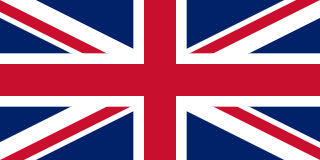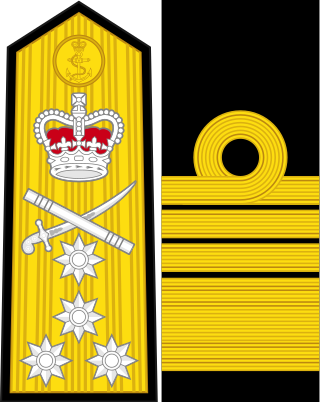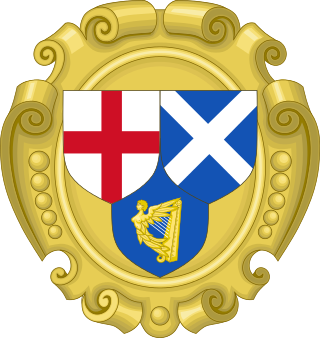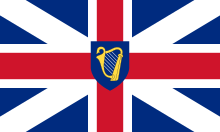
The Commonwealth was the political structure during the period from 1649 to 1660 when England and Wales, later along with Ireland and Scotland, were governed as a republic after the end of the Second English Civil War and the trial and execution of Charles I. The republic's existence was declared through "An Act declaring England to be a Commonwealth", adopted by the Rump Parliament on 19 May 1649. Power in the early Commonwealth was vested primarily in the Parliament and a Council of State. During the period, fighting continued, particularly in Ireland and Scotland, between the parliamentary forces and those opposed to them, in the Cromwellian conquest of Ireland and the Anglo-Scottish war of 1650–1652.

Oliver Cromwell was an English statesman, politician, and soldier, widely regarded as one of the most important figures in the history of the British Isles. He came to prominence during the 1639 to 1653 Wars of the Three Kingdoms, initially as a senior commander in the Parliamentarian army and latterly as a politician. A leading advocate of the execution of Charles I in January 1649, which led to the establishment of The Protectorate, he ruled as Lord Protector from December 1653 until his death in September 1658. Cromwell remains a controversial figure due to his use of the army to acquire political power, and the brutality of his 1649 campaign in Ireland.

Lord Protector was a title that has been used in British constitutional law for the head of state. It was also a particular title for the British heads of state in respect to the established church. It was sometimes used to refer to holders of other temporary posts; for example, a regent acting for the absent monarch.

The Union Jack or Union Flag is the de facto national flag of the United Kingdom. The Union Flag was also used as the official flag of several British colonies and dominions before they adopted their own national flags. The flag continues to have official status in Canada, by parliamentary resolution, where it is known as the Royal Union Flag.

The Protectorate, officially the Commonwealth of England, Scotland and Ireland, was the English form of government lasting from 16 December 1653 to 25 May 1659, under which the kingdoms of England, Scotland, and Ireland, with their associated territories were joined together in the Commonwealth of England, governed by a Lord Protector. It began when Barebone's Parliament was dissolved, and the Instrument of Government appointed Oliver Cromwell as Lord Protector of the Commonwealth. Cromwell died in September 1658 and was succeeded by his son Richard Cromwell.

The flag of England is the national flag of England, a constituent country of the United Kingdom. It is derived from Saint George's Cross. The association of the red cross as an emblem of England can be traced back to the Late Middle Ages when it was gradually, increasingly, used alongside the Royal Banner. It became the only saint's flag permitted to be flown in public as part of the English Reformation and at a similar time became the pre-eminent maritime flag referred to as a white ensign. It was used as a component in the design of the Union Jack in 1606.

The national flag of the United Kingdom is the Union Jack, also known as the Union Flag.

The English Council of State, later also known as the Protector's Privy Council, was first appointed by the Rump Parliament on 14 February 1649 after the execution of King Charles I.
The Interregnum was the period between the execution of Charles I on 30 January 1649 and the arrival of his son Charles II in London on 29 May 1660, which marked the start of the Restoration. During the Interregnum, England was under various forms of republican government.

Admiral is a senior rank of the Royal Navy, which equates to the NATO rank code OF-9, outranked only by the rank of admiral of the fleet. Royal Navy officers holding the ranks of rear admiral, vice admiral and admiral of the fleet are sometimes considered generically to be admirals. The rank of admiral is currently the highest rank to which a serving officer in the Royal Navy can be promoted, admiral of the fleet being in abeyance except for honorary promotions of retired officers and members of the Royal Family.
The Committee of Both Kingdoms,, was a committee set up during the Wars of the Three Kingdoms by the Parliamentarian faction in association with representatives from the Scottish Covenanters, after they made an alliance in late 1643.

Saint Patrick's Saltire or Saint Patrick's Cross is a red saltire on a white field. In heraldic language, it may be blazoned argent, a saltire gules. Saint Patrick's Flag is a flag composed of Saint Patrick's Saltire. The origin of the saltire is disputed. Its association with Saint Patrick dates from the 1780s, when the Anglo-Irish Order of Saint Patrick adopted it as an emblem. This was a British chivalric order established in 1783 by George III. It has been suggested that it derives from the arms of the powerful Geraldine or FitzGerald dynasty. Some Irish nationalists and others reject its use to represent Ireland as a "British invention" "for a people who had never used it".

The Instrument of Government was a constitution of the Commonwealth of England, Scotland and Ireland. Drafted by Major-General John Lambert in 1653, it was the first sovereign codified and written constitution in England.
Edmund Dunch, 1st Baron Burnell of East Wittenham (1602–1678) was an English Member of Parliament who supported the Parliamentary cause before and during the English Civil War. During the Interregnum he sat as a member of parliament. In 1659, after the Protectorate and before the Restoration, regaining his seat in the Rump he also sat in Committee of Safety. After the restoration of the monarchy he was not exempted under the Act of Pardon and Oblivion but the titles granted to him under the Protectorate were not recognised under the restored monarchy of Charles II.
The Commonwealth and Protectorate (1649-1660) refers to the kingless governments of England, Scotland, Great Britain and Ireland during the Interregnum between the actual reigns of the Stuart King Charles I (1625-1649) and his son King Charles II (1660-1685).

The rank of general at sea, was the highest position of command in the English Parliamentary Navy, and approximates to the current rank of admiral. Alongside others, the generals at sea were also appointed as Commissioners for the Admiralty and Navy.

Scotland under the Commonwealth is the history of the Kingdom of Scotland between the declaration that the kingdom was part of the Commonwealth of England in February 1652, and the Restoration of the monarchy with Scotland regaining its position as an independent kingdom, in June 1660.

The interregnum in the British Isles began with the execution of Charles I in January 1649 and ended in May 1660 when his son Charles II was restored to the thrones of the three realms, although he had been already acclaimed king in Scotland since 1649. During this time the monarchial system of government was replaced with the Commonwealth of England.
Vice-Admiral Sir Richard Stayner (1625–1662) was an English naval officer who supported the Parliamentary cause during the English Civil War and the Interregnum. During the First Anglo-Dutch War he commanded the Foresight in actions at Portland, the Gabbard and in the Battle of Scheveningen. During the Anglo-Spanish War (1654–1660), he won renown and a fortune in prize money when he captured a great part of the Spanish West Indian treasure fleet off Cadiz in 1656. He was knighted by the Lord Protector Oliver Cromwell for services in Admiral Robert Blake's destruction of Spanish ships at Santa Cruz, 1657. He was a rear-admiral of the fleet which brought Charles II to England in 1660. He was again knighted at the Restoration. He died at Lisbon, while serving as vice-admiral of the Mediterranean fleet.















